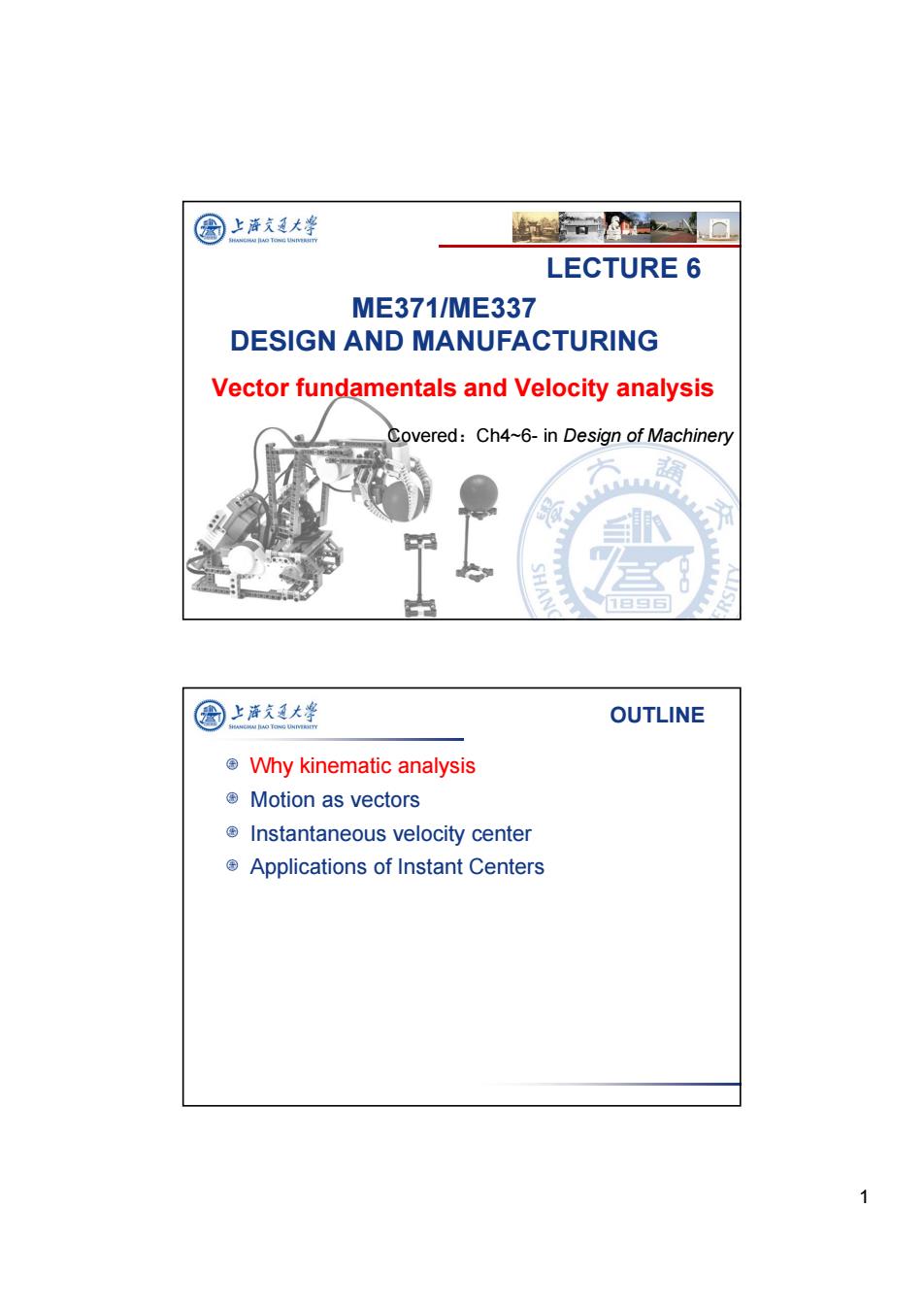
图 上海文通大¥ e2b口 HAa ILAO ToNr:UNpan LECTURE 6 ME371/ME337 DESIGN AND MANUFACTURING Vector fundamentals and Velocity analysis Covered:Ch4~6-in Design of Machinery SH 1 国 上海文通大学 OUTLINE Why kinematic analysis ©Motion as vectors Instantaneous velocity center Applications of Instant Centers 1
1 Vector fundamentals and Velocity analysis LECTURE 6 ME371/ME337 DESIGN AND MANUFACTURING Covered:Ch4~6- in Design of Machinery OUTLINE Why kinematic analysis Motion as vectors Instantaneous velocity center Applications of Instant Centers
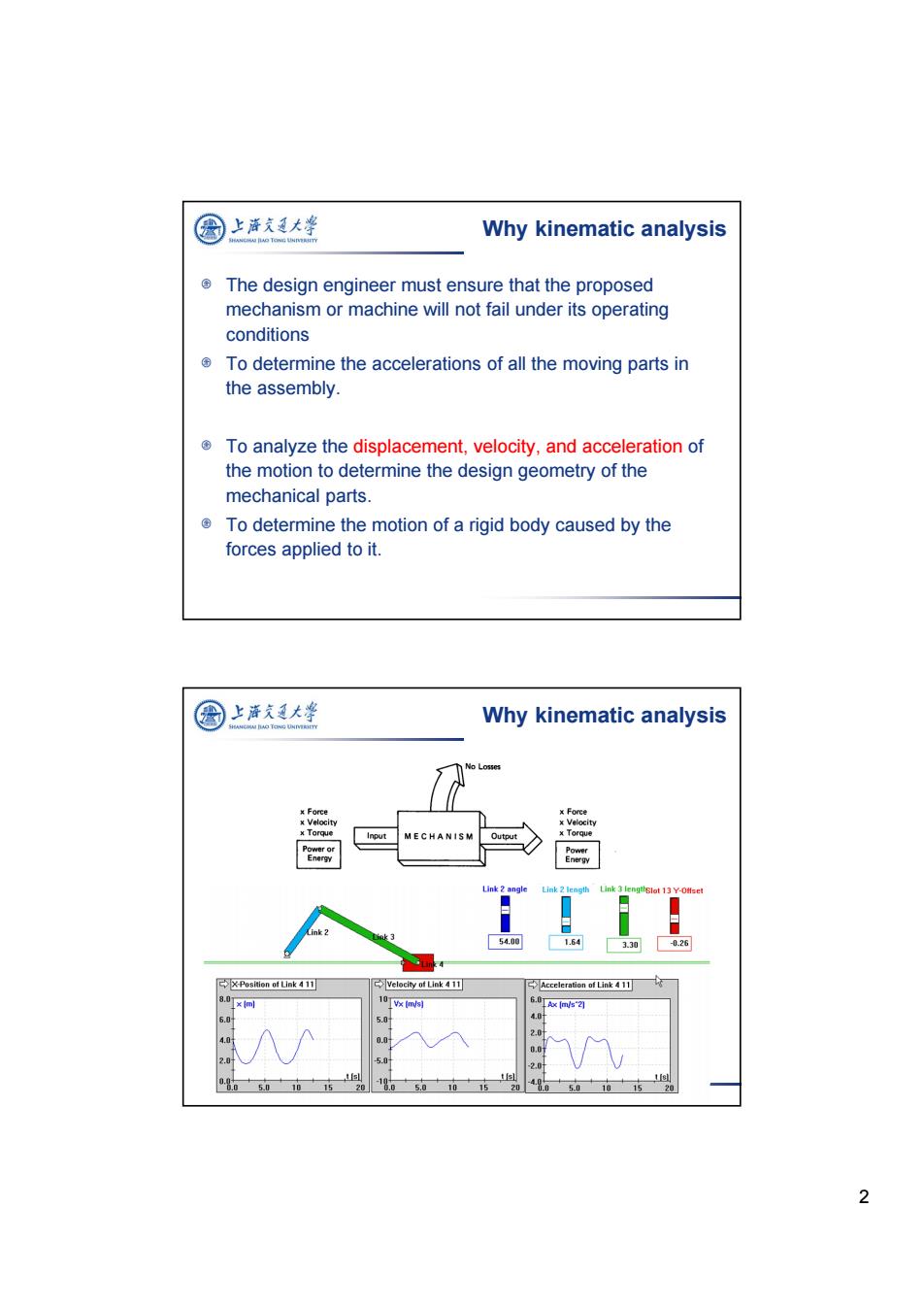
图 上泽久通大学 Why kinematic analysis The design engineer must ensure that the proposed mechanism or machine will not fail under its operating conditions To determine the accelerations of all the moving parts in the assembly. To analyze the displacement,velocity,and acceleration of the motion to determine the design geometry of the mechanical parts. To determine the motion of a rigid body caused by the forces applied to it. 国 上潘久大学 Why kinematic analysis 某Force x Force Velocity x Velocity x Torque Input MECHANISM Dutput x Torque Link 2 angle Link 2 length Link 3 lengtlslot 13 Y-Ofset ◆ 54.00 1.64 330 -0.26 X-Position of Link 4 11 Acceleration of Link 411 8.0 x同 10vx (m/s) 6.Txm2 5.0 00叶 2.0 15 1% 4 5.0 10 15 20 2
2 The design engineer must ensure that the proposed mechanism or machine will not fail under its operating conditions To determine the accelerations of all the moving parts in the assembly. To analyze the displacement, velocity, and acceleration of the motion to determine the design geometry of the mechanical parts. To determine the motion of a rigid body caused by the forces applied to it. Why kinematic analysis Why kinematic analysis
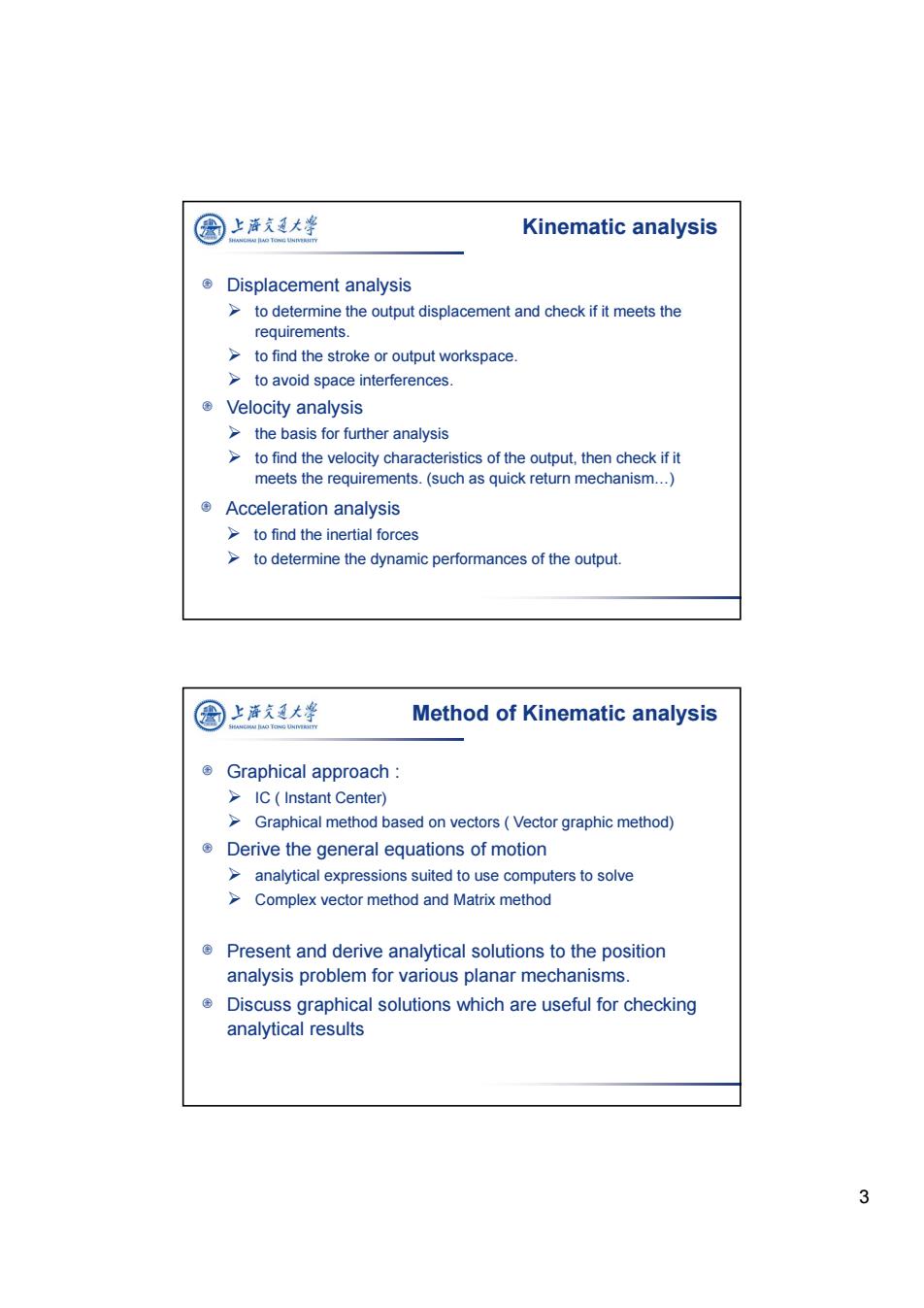
园 上海文通大学 Kinematic analysis Aa ILAO ToNr:UNpin © Displacement analysis to determine the output displacement and check if it meets the requirements. to find the stroke or output workspace to avoid space interferences. ©Velocity analysis the basis for further analysis to find the velocity characteristics of the output,then check if it meets the requirements.(such as quick return mechanism...) Acceleration analysis >to find the inertial forces to determine the dynamic performances of the output. 国 上潘久大学 Method of Kinematic analysis ©Graphical approach: >IC Instant Center) >Graphical method based on vectors(Vector graphic method) Derive the general equations of motion >analytical expressions suited to use computers to solve Complex vector method and Matrix method ® Present and derive analytical solutions to the position analysis problem for various planar mechanisms Discuss graphical solutions which are useful for checking analytical results 3
3 Displacement analysis to determine the output displacement and check if it meets the requirements. to find the stroke or output workspace. to avoid space interferences. Velocity analysis the basis for further analysis to find the velocity characteristics of the output, then check if it meets the requirements. (such as quick return mechanism…) Acceleration analysis to find the inertial forces to determine the dynamic performances of the output. Kinematic analysis Graphical approach : IC ( Instant Center) Graphical method based on vectors ( Vector graphic method) Derive the general equations of motion analytical expressions suited to use computers to solve Complex vector method and Matrix method Present and derive analytical solutions to the position analysis problem for various planar mechanisms. Discuss graphical solutions which are useful for checking analytical results Method of Kinematic analysis
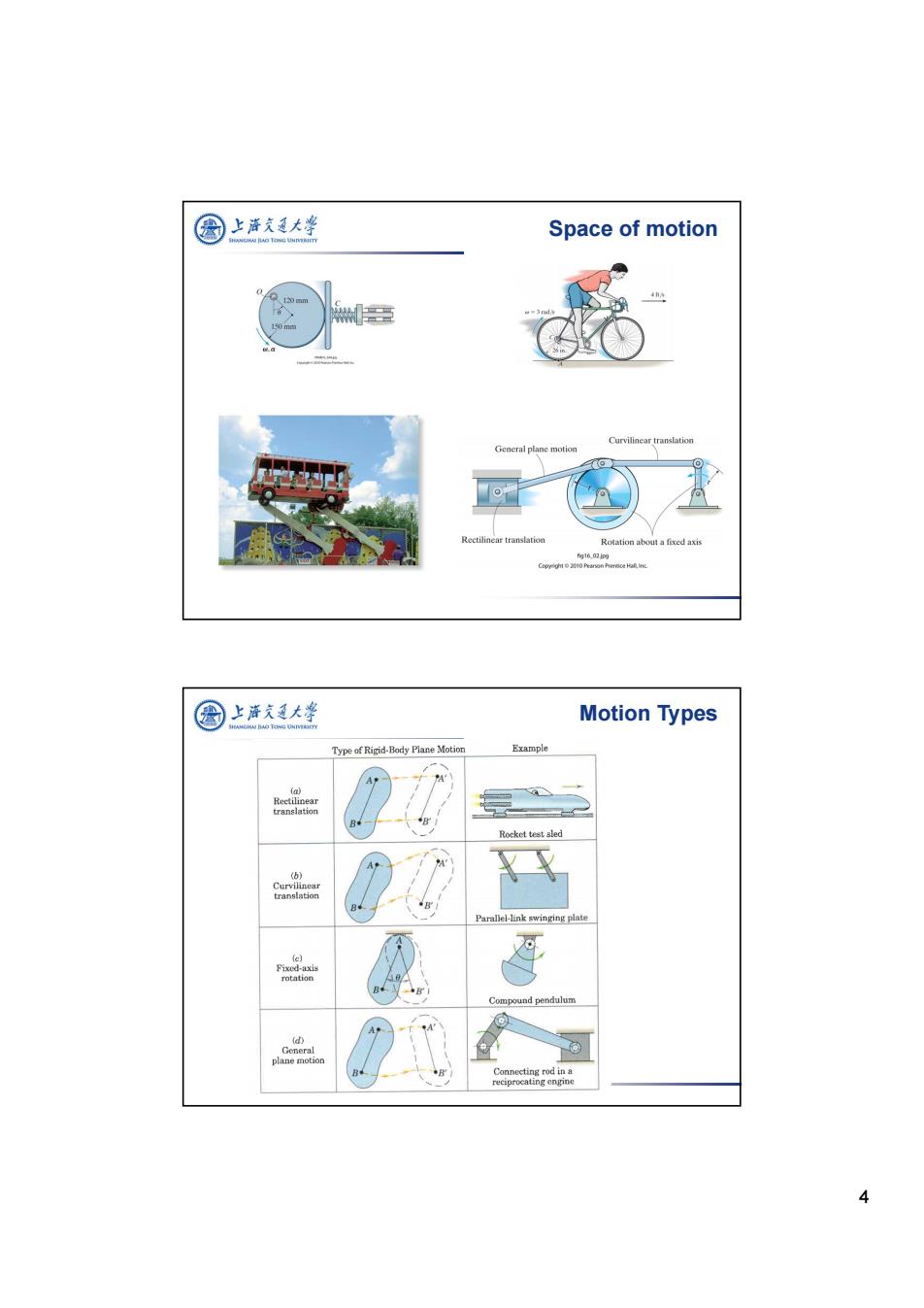
图 上泽文通大¥ Space of motion G从AO TONE时真材 130mm 150m Curvilinear translation General plane motion Rectilinear translation Rotation about a fixed axis 6a2g 国上泽支大半 Motion Types Type of Rigid-Body Plane Motion Example (a) Rectilinear translation Rocket test aled near Parallel-link swinging plate Compound pendulum d 4
4 Space of motion Motion Types
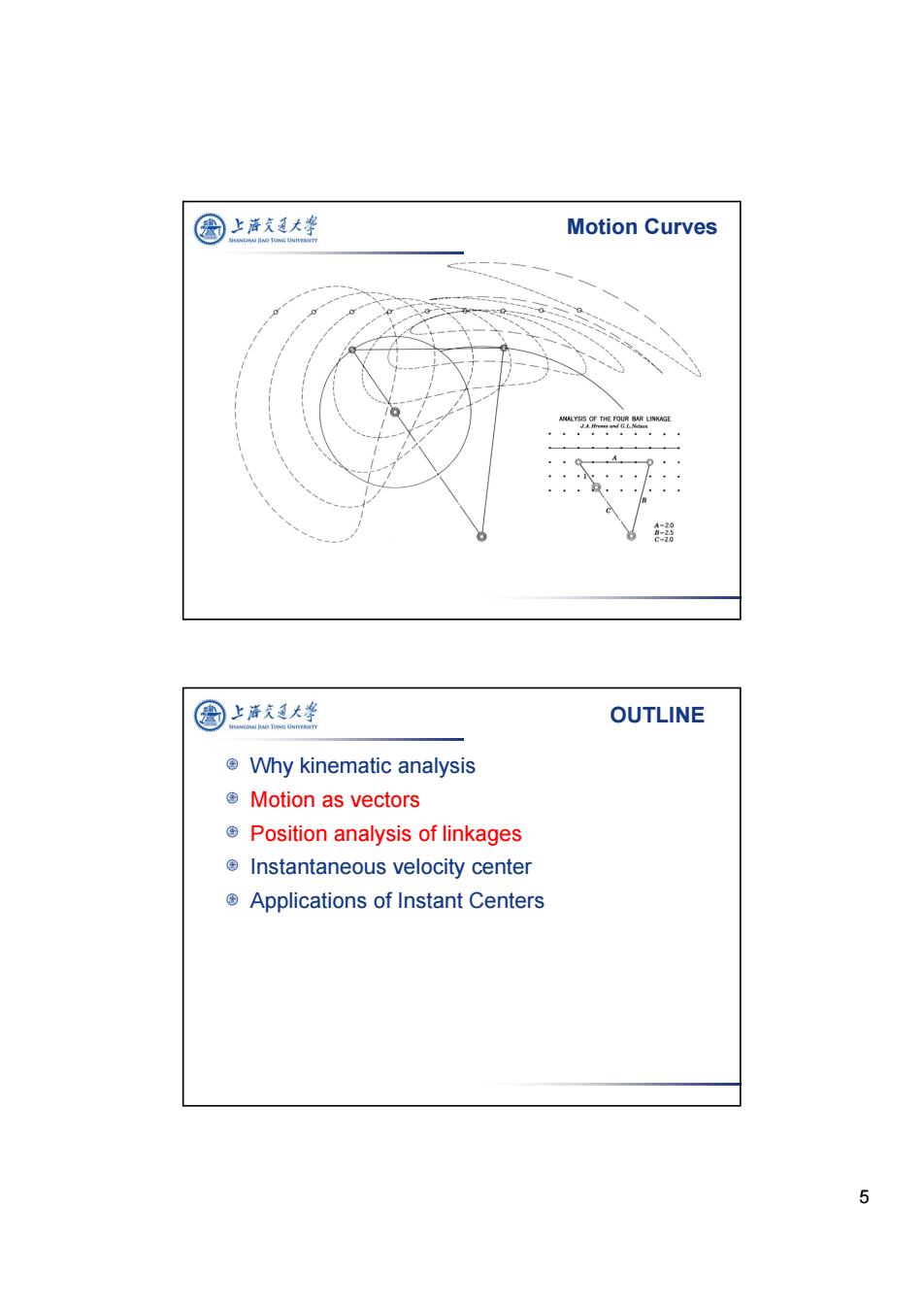
图上泽通大学 Motion Curves GH TONG NR AMALYSIS OF THE FOUR R LINKAGE 国 上潘久大学 OUTLINE Why kinematic analysis ©Motion as vectors ® Position analysis of linkages Instantaneous velocity center Applications of Instant Centers 5
5 Motion Curves OUTLINE Why kinematic analysis Motion as vectors Position analysis of linkages Instantaneous velocity center Applications of Instant Centers

国 上海文通大学 Vector manipulations TON Vector Magnitude Head Magnitude (terminus) Direction Tail (origin) Vector can be represented Graphically R=Ri+Ryj R=R+jRy ◆ Analytically R=[R.RT R=Rei=R(cos0+jsine) 国上泽支大半 Vector manipulations Vector addition: A=Aeio A B=Beia C=A+B C=A+B=Aei+Bei0a =B+A 0 =(Acos0,+Bcoseg)+ (a) j(Asin+Bsineg) A=C-B Vector substraction: A=C-B=Ceic-Beio =(Ccosec-Bcos0g)+ j(Csinec-Bsine) Figure(Vee 6
6 Vector manipulations Vector Magnitude Direction Vector can be represented Graphically Analytically Head Magnitude (terminus) Tail (origin) R R jR x y R e (cos sin ) j R j R [ ]T R R x y R R Ri R j x y Vector manipulations Figure (a) Vector addition and (b) vector subtraction. B A B C A j Ae A B j Be B =( cos cos )+ j( sin sin ) A B j j A B A B Ae Be A B A B CAB =( cos cos )+ j( sin sin ) C B j j C B C B Ce Be C B C B A CB Vector addition: Vector substraction:
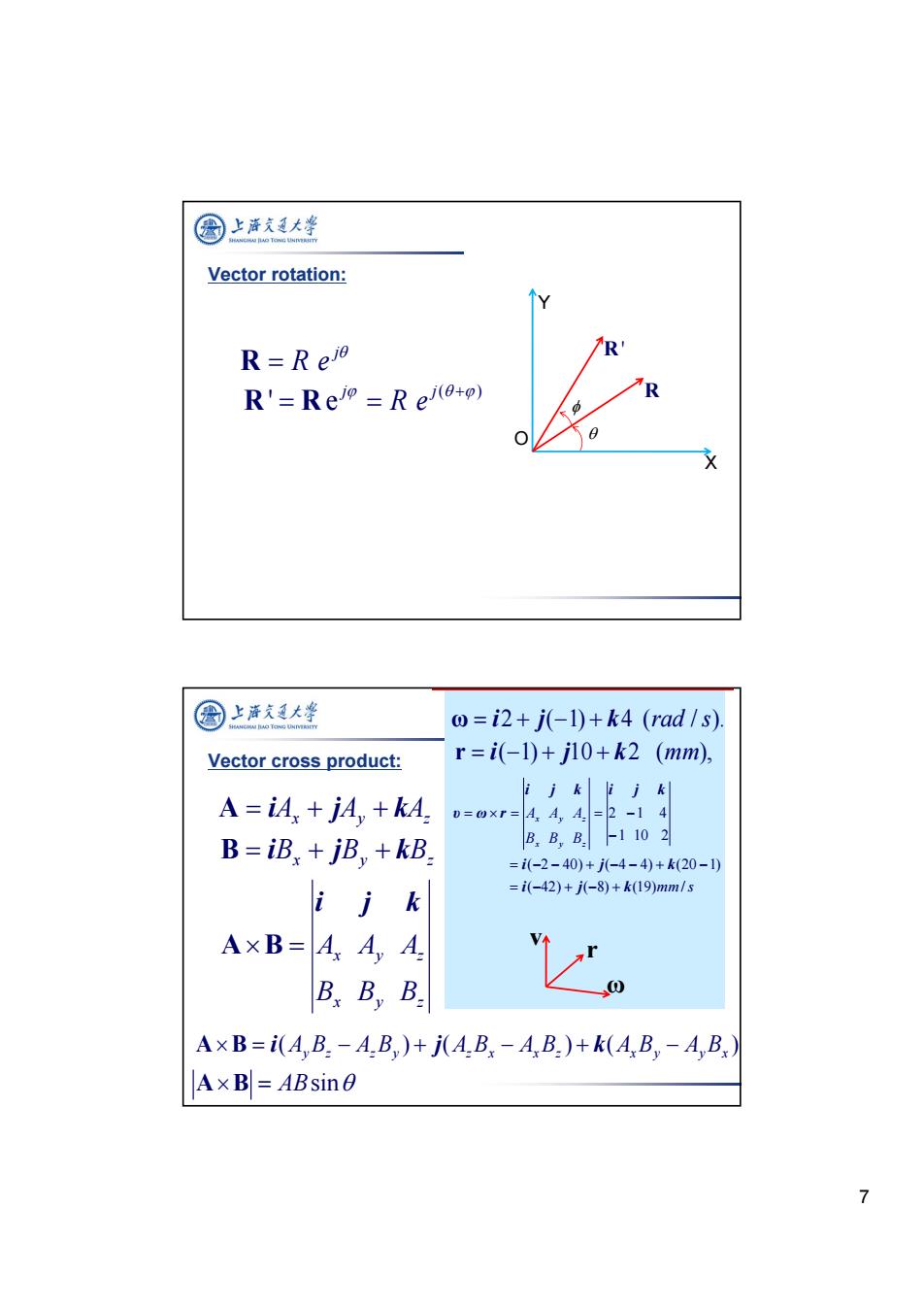
圈上游文大学 Vector rotation: R=Reio R R'=Reio=Rei(o+o) 国上泽支大半 o=i2+j-1)+k4(rad1s). Vector cross product: r=i(-1)+j10+k2(mm), A=iA,jA,+kA. ii i j k D=@xr= B=iB:jBy+kB. -1102 =i(-2-40)+j-4-4)+k(20-1) i jk =i(-42)+j(-8)+k(19)mm/s A×B=AA,A B.B,B. AxB=i(A,B.-A.B)+j(A.B-A B.)+k(A,B-A,B. A×Bl=ABsin0 7
7 Vector rotation: j R e R ( ) 'e j j R e R R X Y O R R ' ω i2 j(1) k4 (rad / s). r i(1) j10 k2 (mm), mm s B B B A A A x y z x y z ( 42) ( 8) (19) / ( 2 40) ( 4 4) (20 1) 1 10 2 2 1 4 i j k i j k i j k i j k υ ω r ω r v Ax Ay Az A i j k Bx By Bz B i j k Vector cross product: x y z x y z B B B A A A i j k AB ( ) ( ) ( ) AyBz AzBy AzBx AxBz AxBy AyBx A B i j k A B ABsin
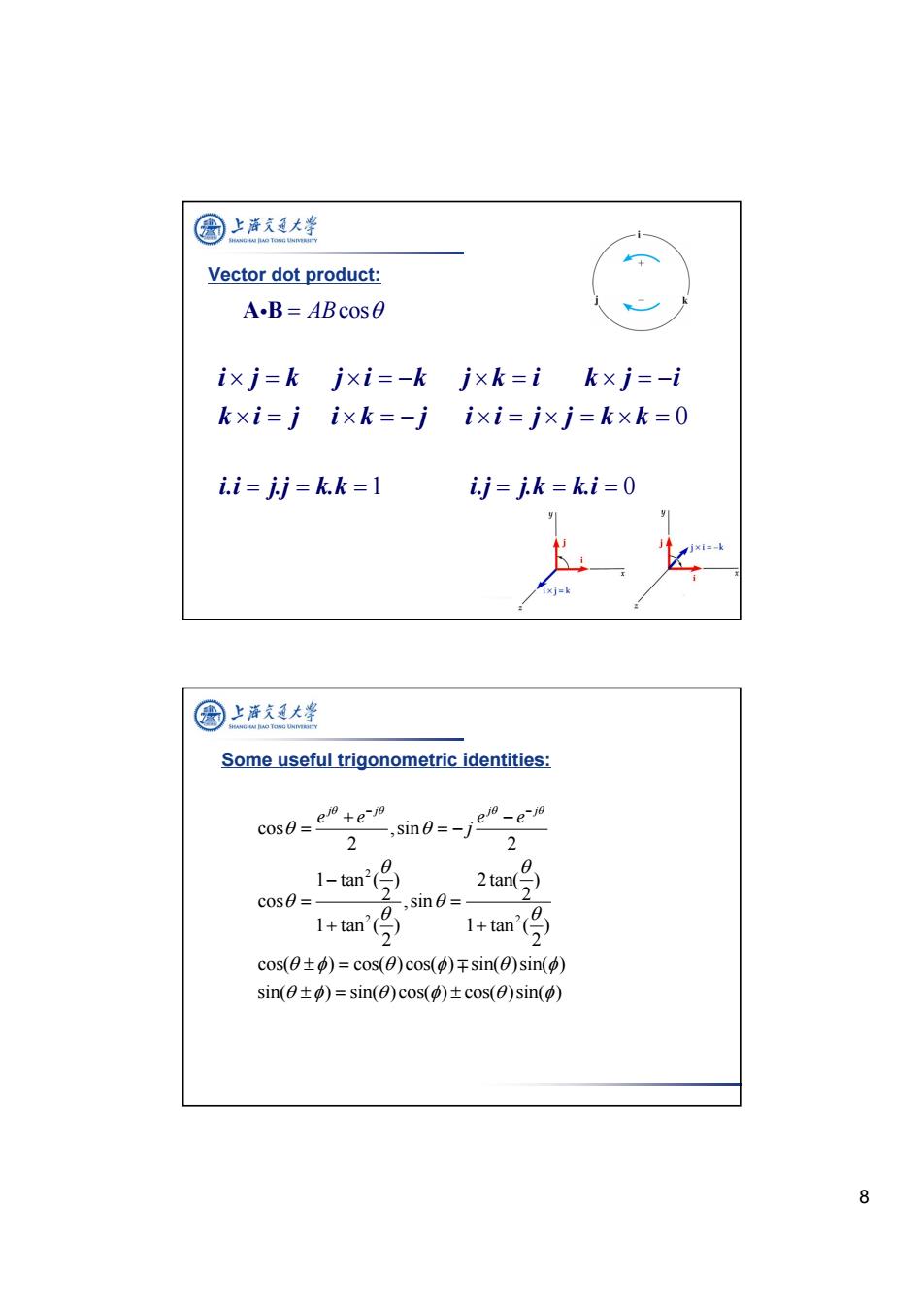
国上泽夫通大学 i Vector dot product: A-B=ABcos0 ixj=k jxi=-k jxk=i k×j=-i kxi=j ixk=-j i×i=j×j=k×k=0 i.i=j.j=k.k=1 i.j=j.k=k.i=0 ixi=-k j=k 国 上海文通大学 Some useful trigonometric identities: COS0=eten 2 .sing=-jen-em 2 1-tan2(3) 2tan() cos0 sin= 1+a3 cos(0±)=cos(0)cos(p)干sin(0)sin(p) sin(0±)=sin(g)cos()±cos(0)sin() 8
8 Vector dot product: A B ABcos 0 k i j i k j i i j j k k i j k j i k j k i k j i i.i j.j k.k 1 i.j j.k k.i 0 Some useful trigonometric identities: 2 2 2 cos ,sin 2 2 1 tan ( ) 2 tan( ) 2 2 cos ,sin 1 tan ( ) 1 tan ( ) 2 2 cos( ) cos( )cos( ) sin( )sin( ) sin( ) sin( )cos( ) cos( )sin( ) jj jj ee ee j

图上泽通大学 Differentiation of complex polar vectors: Let R=R ei represent the position of a point with respect to a fixed reference origin,then First order: d(RRe+R(j)-ke+Roje" Second order: (Re=Re+Rdje+(Ra+0je+RaUe°7间 d -Re0+20Rj er+Rj e-ROelo =(R-R02)ei0+(20R+0R)j ei 上潘久大学 Second order: (R)-Re(Re d' =e+20Re+8Re°-R0e° =(R-RO)e+(20R+0R)j e 20Rj e Rj e hen R ROe 0 9
9 Differentiation of complex polar vectors: j R e Let repres R ent the position of a point with respect to a fixed reference origin, then First order: ( ) ( )= d j jj j j R e Re R e j Re R j e dt 2 2 2 2 Second order: ( ) ( ) ( ) ( ) = 2 =( ) +(2 ) jj j j j j j jj j d R e Re R j e R R j e R je j dt Re Rj e Rj e R e RR e R R j j e X Y O R j j e j Re j R j e j e j Re 2 j R e 2 j Rj e j Rj e P 2 2 2 2 Second order: ( ) ( ) ( ) ( ) = 2 =( ) +(2 ) jj j j j j j jj j d R e Re R j e RR j e R je j dt Re Rj e Rj e R e RR e R R j j e
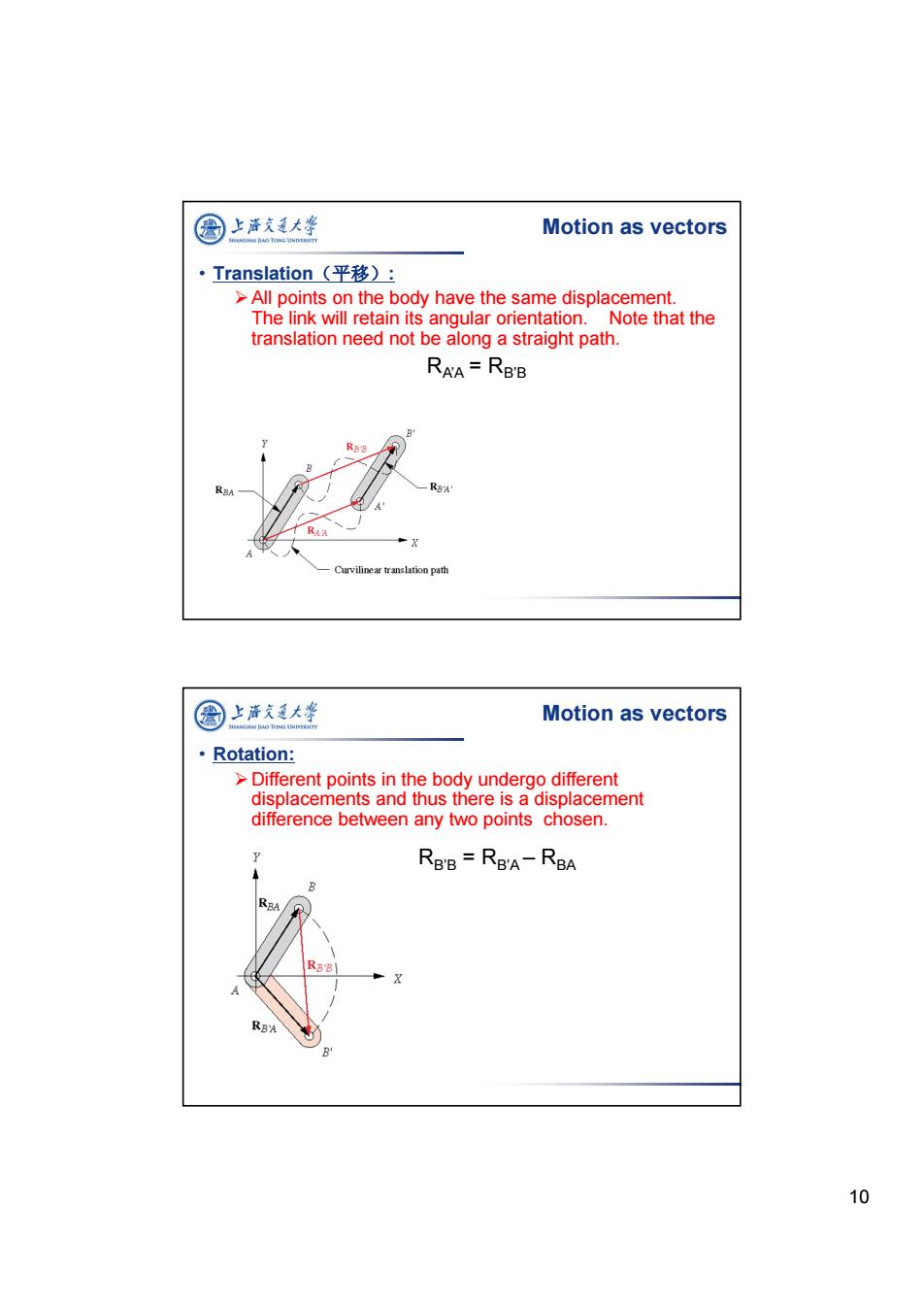
图 上海文通大¥ Motion as vectors ·Translation(平移): >All points on the body have the same displacement. The link will retain its angular orientation.Note that the translation need not be along a straight path. RAA=RBB R RBB RBA RBA RA Curvilinear translation path 国上泽支大半 Motion as vectors ·Rotation: >Different points in the body undergo different displacements and thus there is a displacement difference between any two points chosen. RBB=RBA-RBA RBA RB'B RBA 10
10 • Translation(平移): All points on the body have the same displacement. The link will retain its angular orientation. Note that the translation need not be along a straight path. RA’A = RB’B Motion as vectors • Rotation: Different points in the body undergo different displacements and thus there is a displacement difference between any two points chosen. RB’B = RB’A – RBA Motion as vectors